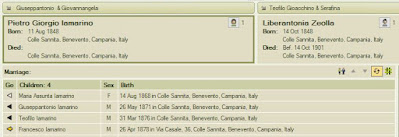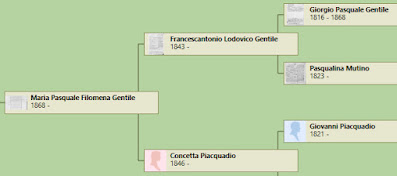I've tried using subscription newspaper websites for my family tree research. I never get anywhere.
My ancestors were not in the society pages. They weren't captains of industry. All I've ever found are some of my great grandfather's real estate transactions.
Today I tried a different approach. I learned more about my ancestors' lives by examining one important historical event.
 |
| This Nov. 7, 1917 New York Tribune headline is my grandfather's story. |
I turned to the free, online resources of the Library of Congress. Their "Chronicling America" project gives you access to historic American newspapers from 1789 to 1963.
To get started, choose a state and a range of years. You can also try adding some keywords to your search.
How I Chose My Historic Event
Last month while visiting Italy I saw and photographed my grandfather's World War I military record. I know the name and dates of the major battle in which he was captured. I know he was a prisoner of war for a full year.
He had been in New York before the war. He'd joined a few of his first cousins in Manhattan and was working as a shoemaker, living with his cousin.
 |
| A dream come true! Visiting the Italian archives to see my grandfather's records. |
When his Italian Army regiment called him up for duty, he sailed back home. He was in the infantry in 1915. He was promoted to Corporal on January 1, 1917.
Then, like a few hundred thousand other Italian soldiers, my grandfather was captured in the Battle of Caporetto. The German Army imprisoned him in Mauthausen, Austria, for one year.
Using the Library of Congress, I searched the New York Tribune newspaper for the dates of the Battle of Caporetto. I watched the story unfold on the front page of the paper day after day.
I read about the prisoners, the casualties, and the devastating losses.
Did my grandfather's first cousins—the ones who stayed in New York City—read this too? Did they wonder if their cousin Adamo was part of this epic battle? Did they wonder if he'd been killed or captured?
Now It's Your Turn
Today we get our news so fast, it's hard to imagine waiting for the newspaper to tell you what's happening in the war overseas.
Here's how you can put these free, digitized newspapers to work for you. Choose an event from history that was big news during your ancestor's lifetime. Something they would have heard about nearly every day.
Narrow your search to a single year. Click the checkbox to show only front pages. You'll see much more at a time, and the biggest stories will be on the front page. Look at the captions and find the most important date for this event. Then click that image.
 |
| Get started searching American newspapers from the Library of Congress. |
You can view the newspaper page by page, zoom in and out, and save any page as an image or a PDF. If your story is really big news, click to go to the next issue.
By looking at the front pages of several newspaper issues, I saw the story of my grandfather's World War I battle unfold day by day. This battle has great significance for my family history.
What were the big stories that changed your ancestors' lives?











